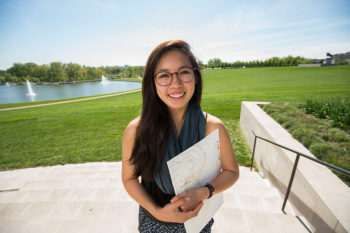
Alexandra Mei, who will receive a Bachelor of Design in Architecture, outside her studio in Forsyth House.
Photo by Joe Angeles
As a senior in the Sam Fox School of Design & Visual Arts, you helped organize a national symposium on “Women in Architecture.” How did that come about?
Last year, my friend Shannon Slade started a group of us in the junior class to talk about issues relating to gender and equality. We all were seeing differences in the ways studio culture treats women and men. For example, architecture schools admit a lot of female students, but you don’t see that reflected in the profession or in major architecture awards.
“Women in Architecture” marked the 40th anniversary of a similar symposium held at Washington University in 1974. How have things changed, or not, during that time?

Alexandra Mei, a senior in the Sam Fox School, will study landscape architecture at Harvard’s Graduate School of Design next fall.
Photo by Joe Angeles
Forty years ago, the problem was obvious: Women weren’t well represented in architecture. Today the issues are more subtle. It’s not just about the numbers — at the Sam Fox School, we have a predominantly female class! It’s about the way we treat one another, the way we talk to one another. It’s about what we think an architect looks like.
As co-founder of the WashU Design for America studio, you’ve helped students explore new strategies for implementing sustainable design. Next fall, you’ll study landscape architecture at Harvard’s Graduate School of Design. What drew you to that?
I’m really interested in the combination of landscape and urbanism — in looking at integrated systems and environments and how they affect people on a larger scale. There’s so much potential for landscape architecture today to impact issues both within and beyond the site in front of you.

As part of the Sam Fox School’s cross-disciplinary studio “Urban Books,” Mei tracked pedestrian usage and pathways across Art Hill in Forest Park.
Photo by Joe Angeles
This semester, I’ve been researching the Maldives islands, which are essentially sinking due to climate change. In 100 years, they’ll be uninhabitable. And yet many people still can’t admit that climate change exists! That affects policy, and policy affects a huge number of ecological and environmental issues.
I want to explore how my role as a designer can influence such challenges and reach beyond aesthetics to questions of social and environmental equity.